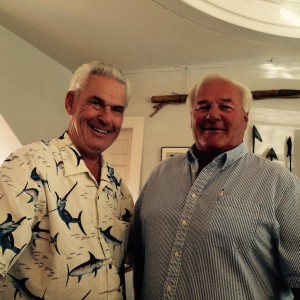By the age of ten, Tom Brownell had witnessed the thrill and the danger associated with swordfishing.
One day, while hunting for swordfish, about 30 miles south of Martha’s Vineyard with his Dad, a fish was “ironed.” But on this day, the enormous animal reared up from underneath their boat and pierced the deck clear through the planking with its massive sword. The surprised youth and his father quickly stuck rags into the breach not unlike putting a finger in a dike.
On July 23, Brownell and his hunting partner of many years, John Clark, told a group gathered at the Mattapoisett Historical Society Museum to hear fishing tales, “…we’ve got so many stories…” Thus, Brownell and Clark shared a few of those tales and, as they spoke, their eyes seemed to view the scenes they were describing in that far distance of time where the horizon meets the sea.
They talked about the mechanics involved in hunting these great fish. To ‘iron’ a swordfish means to spear it with a special tool that allows the spearhead to disengage from the shank. The spear is attached to a long rope line. On the other end is a large ball. Once speared, the swordfish swims until exhausted while the hunters follow, waiting for the opportunity to bring the huge animal aboard the boat.
Brownell said, during his youth, he fished with Earl Broadman of Hollywood in a boat built by Brownell’s family business. Each summer, he would go on as many as 35 fishing trips. After that, Brownell began partnering with Tommy Borges (now deceased) and John Clark. He said each man had his own finely-honed individual skills and jobs during the hunt. Borges was the wheelman, Clark was the spotter and angler, and Brownell was the striker, spearing the fish. They were tuned in to each other, had confidence in each other, and were successful for that reason the men shared.
“Johnny would tend the line. Tommy would steer the boat, putting the sun to my back, said Brownell. “Tommy knew just how I liked it and put me right on the fish. I was the striker.” Brownell demonstrated the stance he would take as he spoke.
Striking the fish needed to be precise to set the spearhead. Then the fish would take off trailing 300 feet of line. It would take up to 60 minutes before they could attempt landing the fish. Clark never took his eye off the ball and when the time came, Brownell said, “Johnny did most of the fighting with the fish.”
Brownell described the perfect hunting day as one where “we had popcorn skies” and flat calm waters. He said Clark could spot a swordfish fin yards away.
Fishing began in June and ended in September. They went out to sea “every good day,” Brownell remembered. And for more than 30 years, he remembered many good days.
During the season, swordfish migrate north following baitfish. The men would head out around dawn and return after dark. It took two to three hours to reach the hunting grounds some 30 miles south of Martha’s Vineyard.
And swordfish weren’t the only fish they saw.
He said the ocean was full of all types of sharks and whales. Clark remembered what he saw on one day in particular.
“Acres of black whales, as far as the eye could see, sleeping on the surface of the water,” said Clark.
Seth Mendell, who was among the assembled to hear these men speak, offered the following explanation, “Whales are mammals and have to sleep on the surface of the water so they can breath. They are the only mammals who can shut off half of their brains while sleeping, while the other half keeps them breathing.”
The biggest swordfish the trio ever brought in weighed 504 pounds after being “dressed.” But the very best day of his fishing life was July 17, 1983. On that day, they landed six fish weighing from 190 to 400 pounds.
Brownell said that swordfishing’s heydays ended around 1985 with the arrival of factory ships from Russia invading George’s Banks.
“At night, there were so many huge ships from Russia all lit up, it looked like a city on the ocean,” said Brownell. He said these industrial ships used long nets sweeping everything out of the water from fish, to sharks, to whales, everything. “And the water seemed to warm up a lot,” which Brownell said contributed to the decline of baitfish.
When the fishermen first began selling their catch to local restaurants, the price was around 25 cents per pound. That figure rose to six dollars per pound by 1985.
Brownell said, of the years he fished with Tommy Borges and Johnny Clark, “We never really grew up.” He concluded wistfully, “It was the best time any three guys could have!”
You can view photographs of Brownell and his partners during their days at sea and related tools of the trade at the Mattapoisett Historical Society Museum through the summer season.
By Marilou Newell
